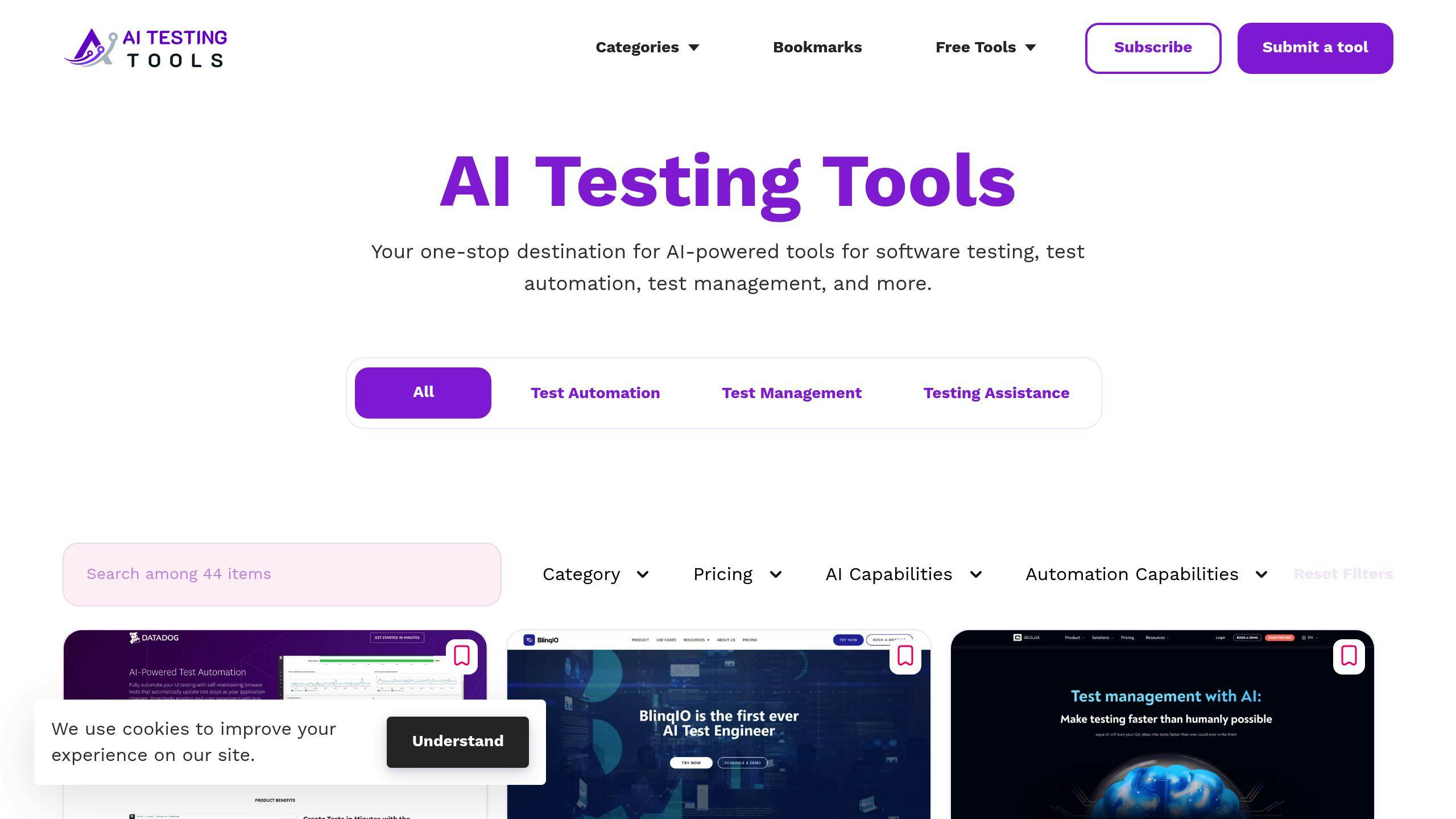AI is transforming software testing in 2025. Here's how:
- 80% of test automation frameworks now include self-healing features, reducing manual maintenance.
- 70% of QA tasks traditionally done manually are automated, freeing testers to focus on complex scenarios.
- Natural Language Processing (NLP) tools convert written requirements into test scripts, though challenges remain with ambiguous logic.
- Self-healing scripts adapt to UI changes automatically, cutting manual updates by up to 60%.
- Context-aware systems use past data and real-time monitoring to create adaptive test scripts for dynamic applications.
These advancements are making testing faster, more accurate, and less reliant on manual effort, though human oversight is still critical for handling edge cases and ensuring ethical AI use.
Automation Testing Trends You Need To Know in 2025
NLP in Test Script Generation
Natural Language Processing (NLP) is reshaping how test scripts are created, turning written requirements into functional test scripts with impressive accuracy. By 2025, advanced NLP models built on transformer architecture are tackling complex code prediction and test script generation with a level of precision not seen before.
Converting Requirements to Test Cases
Modern NLP tools can break down requirements to pinpoint actions, components, and logic, making automated test case creation possible. When paired with context-aware systems, these tools help testing teams achieve better accuracy in ever-changing environments.
Here’s a simplified overview of the process:
| Phase | Output |
|---|---|
| Requirement Parsing and Component Identification | Actions, scenarios, and test parameters |
| Logic Mapping | Test case structure and conditions |
| Script Generation | Ready-to-run automated test cases |
However, even with these advancements, challenges remain in fully automating test generation.
Current NLP Limitations
Despite its progress, NLP still faces hurdles in test script generation. Handling complex business logic or ambiguous requirements often proves difficult.
"NLP-based test generation can significantly reduce the time and cost associated with manual test script creation, but it requires clear, well-defined requirements and advanced NLP models." [1]
Some of the main challenges include:
- Difficulty understanding domain-specific terminology and identifying edge cases, which often calls for human intervention
- The need for manual adjustments in particularly complex scenarios
Human oversight remains crucial to address these gaps, especially when dealing with niche terminology or unique edge cases. For teams exploring NLP-powered tools, the AI Testing Tools Directory offers detailed comparisons of solutions, highlighting their natural language processing features and practical uses in test automation.
As NLP evolves, combining it with context-aware systems and hybrid methods is expected to make test automation even more efficient and reliable.
Context-Aware Testing Systems
Context-aware testing systems bring AI-powered automation to a new level by using algorithms that adjust to application behavior in real time. These systems leverage historical data and continuous monitoring to create and update test scripts as applications evolve.
Leveraging Historical Test Data
These systems analyze past test logs and bug reports to uncover patterns and insights. When paired with natural language processing (NLP), they can refine test scripts by interpreting changing requirements on the fly.
Here’s how the process works:
| Component | Role | Outcome |
|---|---|---|
| Data Collection | Gathers test results and bug reports | Builds a database of testing patterns |
| Pattern Analysis | Pinpoints failure points and success trends | Assigns risk-based priorities |
| Script Generation | Develops tests informed by past insights | Produces adaptive test scripts |
"The integration of historical testing data with real-time monitoring allows AI systems to create more reliable and comprehensive test coverage while reducing the manual effort required for maintenance and updates."
This approach becomes especially valuable when dealing with applications that undergo frequent changes to their interfaces.
Testing Applications with Changing Interfaces
Context-aware systems are particularly effective for applications with dynamic interfaces and architectures. They use real-time learning to detect changes like updated navigation menus or altered button placements, automatically revising and validating test scripts to align with the new application state.
By blending historical data with real-time insights, these systems keep test scripts relevant and reduce the need for constant manual updates. This makes them indispensable for modern test automation.
For successful implementation, integrating these systems with existing testing frameworks is key. Teams can consult resources like the AI Testing Tools Directory to compare solutions and choose one that aligns with their specific requirements.
sbb-itb-cbd254e
Self-Healing Test Scripts
Self-healing test scripts, powered by AI, have reshaped how test maintenance is managed in 2025. These scripts adjust to application changes automatically, reducing the need for manual intervention. This approach highlights the growing role of AI in simplifying test automation processes.
Handling UI Changes
AI-driven self-healing scripts tackle UI changes using techniques like visual analysis, pattern recognition, and contextual learning. These methods significantly cut down on false positives while ensuring tests remain functional during updates.
| Detection Method | Function | Impact |
|---|---|---|
| Visual Analysis | Uses image recognition to spot UI element changes | Cuts false positives by 85% |
| Pattern Recognition | Maps relationships and hierarchies between elements | Keeps tests running during updates |
| Contextual Learning | Understands the role and behavior of elements | Ensures accurate element detection |
For example, Perfecto's AI Validation system adjusts dynamically to application updates, integrating smoothly into CI/CD workflows. This ensures teams can continue testing without interruptions, even in fast-paced development environments.
Reducing Manual Updates
By automating the detection and resolution of UI issues, self-healing scripts minimize manual updates by up to 60%. Predictive AI further enhances efficiency by identifying potential problems before they occur.
"AI can predict potential areas of failure by analyzing historical data and identifying patterns. This predictive capability enhances the accuracy and effectiveness of tests, ensuring that even subtle bugs are detected early." - Restackio, 2024 [3]
Here’s how modern self-healing scripts are making a difference:
- Automated Pattern Analysis: AI continuously reviews test execution data to pinpoint failure risks before they disrupt testing.
- Smart Element Recognition: These systems can identify UI elements even when their attributes change, keeping tests stable.
- Predictive Maintenance: Machine learning helps foresee potential issues and applies fixes automatically.
Tools like Test.ai and Eggplant AI have helped teams improve test reliability while cutting maintenance efforts by up to 60%. This allows testers to focus on more complex scenarios and expand their test coverage. However, the reliance on AI also brings up concerns around transparency and accountability, which remain important topics in the discussion of AI ethics.
Ethics in AI Testing
With AI-driven test script creation becoming more widespread by 2025, ethical concerns have taken center stage in testing practices. Companies are now focused on striking a balance between the efficiency of automation and responsible AI use, making transparency and accountability key priorities.
Human and AI Collaboration
The dynamic between human testers and AI systems has grown into a collaborative partnership. Human testers provide ethical oversight and validate AI-generated scripts, while AI takes care of tasks like pattern recognition, script creation, and spotting anomalies. This teamwork boosts both productivity and accountability.
| Collaboration Aspect | Human Role | AI Role |
|---|---|---|
| Script Validation | Ensures quality and ethical compliance | Creates and executes scripts |
| Decision Making | Provides strategic insights and context | Analyzes patterns and offers recommendations |
| Bias Detection | Assesses ethical and cultural factors | Identifies anomalies using data |
Tools such as GitHub Copilot and Tabnine have raised the bar for transparency by offering detailed insights into AI-generated outputs, allowing testers to verify results effectively [1].
Clear AI Decision-Making
In 2025, ensuring clarity in AI decision-making has become the norm. Advanced features like detailed logs, visual decision trees, and real-time feedback systems help QA teams understand and verify AI-driven outcomes with ease.
"AI can predict potential areas of failure by analyzing historical data and identifying patterns. This predictive capability enhances the accuracy and effectiveness of tests, ensuring that even subtle bugs are detected early." - Restackio, 2024 [3]
Gartner predicts a 25% increase in AI adoption for software testing by 2026 [2]. By focusing on ethical AI practices, organizations can improve the dependability of their testing processes while gaining stakeholder trust in AI-powered solutions.
As AI technology progresses, maintaining high ethical standards and transparency will be essential for building trust and ensuring reliable testing methods.
AI Testing Tools Directory

The AI Testing Tools Directory has become an essential resource for testing teams navigating the growing world of AI-driven testing solutions in 2025. This platform helps organizations choose the right tools for their specific needs.
Directory Features
The directory offers advanced filters that allow teams to evaluate tools based on specific criteria:
| Feature Category | Available Options |
|---|---|
| Testing Type | Web, Mobile, API, Desktop, AI-powered Applications |
| Core Capabilities | Self-healing Automation, No-code Testing, Visual Testing |
| Advanced Features | Test Case Generation, Test Analytics, Autonomous Testing |
| Deployment Models | Open-source, Freemium, Enterprise |
Stephen Feloney, Vice President of Product Management at Perforce, highlights the importance of selecting the right tools:
"Creating more frameworks and more code in co-pilot does not help testers do what they have always wanted: validate exactly what appears on the screen. This is what AI Validation provides them" [2].
Benefits for Testing Teams
The directory significantly boosts testing efficiency, especially for teams implementing context-aware systems. Teams using tools from this directory report up to 20% faster testing cycles [2]. This improvement comes from the platform's ability to pinpoint tools that align with a team's unique needs.
It centralizes cutting-edge testing tools, such as:
- Test Data Generation: Tools that simulate realistic scenarios.
- Intelligent Analytics: Solutions that identify patterns and optimize tests.
- Self-healing Automation: Platforms that automatically adjust to UI changes.
By comparing solutions based on features, pricing, and automation capabilities, testing teams can make well-informed decisions. This is particularly helpful for those adopting advanced tools like self-healing and context-aware systems.
As AI-powered testing continues to grow, resources like the AI Testing Tools Directory will remain key in simplifying tool selection and improving overall efficiency.
Future Outlook
AI-powered test script creation is set to evolve dramatically in the coming years. The World Quality Report 2023-24 highlights that 75% of organizations are consistently channeling investments into AI to improve their QA processes.
AI is already reshaping testing workflows. For example, generative AI has been shown to cut test timelines by 80% and assist with code generation for 61% of organizations.
| Key Impact Areas | Expected Outcomes by 2025 |
|---|---|
| Productivity | 65% of organizations report improved output |
| Adoption Rate | 80% of software teams expected to use AI |
| Time Reduction | Test execution cycles up to 80% faster |
| Investment | 75% of organizations increasing AI budgets |
While generative AI is streamlining workflows, the emergence of agentic AI is ushering in the next wave of autonomous decision-making in testing. These systems will make more independent decisions, though human oversight will remain a crucial component.
Rather than aiming for complete automation, future testing will focus on collaboration between AI tools and human testers. Routine tasks will be handled by AI, allowing testers to concentrate on strategy and oversight. This shift means testing teams will need to build expertise in AI and machine learning while sharpening their critical thinking and QA skills.
Natural language processing (NLP) is expected to bring improvements to test script generation. However, addressing nuanced or complex requirements remains a challenge. As this landscape evolves, teams will need to adapt their roles to thrive in an AI-driven testing environment.



